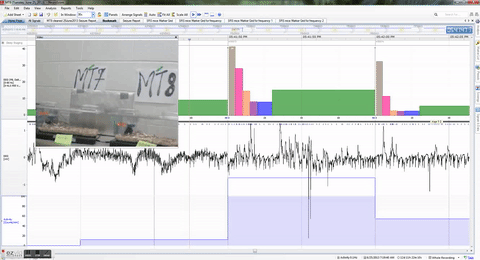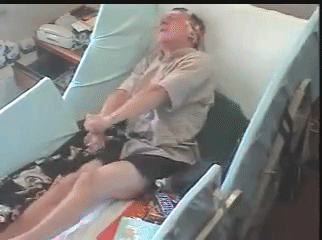Seizures
A seizure is a medical condition caused by the excessive or synchronous firing of neurons. Normally brain activity is non-synchronous.
A seizure is an acute episode. Epilepsy is a chronic condition involving multiple unprovoked seizures. In the majority of epilepsy patients, the cause of the disease is unknown or idiopathic. Brain tumors, strokes, head traumas, and neurodegenerative diseases can all play a role in epilepsy.
Isolated seizures can be triggered by a multitude of medical conditions or physiological imbalances. They are often associated with alcohol withdrawal, liver failure, or a metabolic imbalance such as low salt or high concentrations of waste products in the bloodstream. High fevers can also cause seizures, particularly in young children.

 These images show a mouse and its brainwaves as it moves from normal brain activity (top image) to a seizure (bottom image).[1]
These images show a mouse and its brainwaves as it moves from normal brain activity (top image) to a seizure (bottom image).[1]
Contents
Physiology
 This electroencephalogram (EEG) shows typical brain wave patterns. [2]
This electroencephalogram (EEG) shows typical brain wave patterns. [2]
Seizures can be classified into two broad categories, depending on how much of the brain is involved in the abnormal neuronal activity.
- Partial seizures affect a specific area of the brain. They are also called focal seizures
- Generalized seizures are marked by changes in neuron activity throughout the brain. In the tonic phase of the seizure, the muscles are stiff. The patient may fall to the ground or rigidly extend all their limbs. In the clonic phase, the patient exhibits repetitive, jerking movements. Absence seizures (petit mal seizures) are the most common type of seizure. They typically last 10-15 seconds.
Status epilepticus is a seizure that lasts more than five minutes, or a series of seizures where a new seizure starts before the patient can regain consciousness from the last seizure.
 A grand mal seizure is also called a generalized tonic clonic seizure.[3]
A grand mal seizure is also called a generalized tonic clonic seizure.[3]
The signs and symptoms of a seizure can vary, depending on the type of seizure. Some patients have a warning aura, a period where they are conscious and experiencing abnormal sensations, such as a sense of fear or smelling a specific smell. By contrast, people having absence seizures may be unaware that they have experienced a seizure at all. People interacting with the patient may not recognize the event as a seizure either; they may just think the patient was momentarily distracted.
 EEG of a petit mal seizure.[4]
EEG of a petit mal seizure.[4]
Seizures require huge amounts of energy and can alter the blood chemistry and pH. People often experience muscle weakness and extreme fatigue after a seizure, because their ATP stores are depleted.
Treatment
Around 70% of epileptic patients can gain control of their seizures through medications or surgery.[5] Several different classes of medications can be used to prevent seizures. Some decrease the concentration of excitatory neurotransmitters, Others increase the concentration of inhibitory neurotransmitters, Whatever the mechanism, the goal of therapy is the same: decreased neuron activity. Surgery to remove part of the brain is a treatment option for patients whose seizures are not adequately controlled with medications. While it can be very effective, the risks are also extreme.
A Ketogenic diet is high in fat and low in both protein and carbohydrates. In a ketogenic diet, around 90% of calories are supplied from fat (compared to about 30% in a typical diet). The nutrient balance is altered to supply less energy to the brain, decreasing neuronal excitation. This diet mimics the effects of starvation and forces the body to use fat as its primary fuel source. Ketogenic diets require careful monitoring by a physician and a nutritionist to ensure the patient receives enough calories, fluid, and proteins. All portions must be weighed to ensure the energy ratio is correct. Children who suffer from daily seizures are good candidates for a ketogenic diet. Generally, the patients have difficulty following the strict diet, in part because the meals are unpalatable. Fats are provided through heavy cream, butter, and vegetable oil, while sweets and enriched carbohydrates are eliminated entirely. An example breakfast might be one egg, scrambled with several tablespoons of butter and heavy cream, served with a single strawberry. Lunch might consist of a chicken salad that's four parts heavy cream and mayonnaise to one part chicken, served on a lettuce leaf with a side of cucumbers.
References
- Puttachary, S., & Sharma, S. Immediate Epileptogenesis after Kainate-Induced Status Epilepticus in C57BL/6J Mice: Evidence from Long Term Continuous Video-EEG Telemetry. PLOS ONE.
- Bemoeial~commonswiki, . ElectroEncephalogram. Retrieved from https://commons.wikimedia.org/wiki/File:ElectroEncephalogram.png
- Misra, V. Generalized Tonic Clonic Seizure (GTCS). Retrieved from https://www.youtube.com/watch?v=hciaAeYLJSw
- Der Lange, . Spikes Waves. Retrieved from -https://commons.wikimedia.org/wiki/File:Spike-waves.png
- National Institute of Neurological Disorders and Stroke, . Epilepsy Information Page. Retrieved from http://www.ninds.nih.gov/disorders/epilepsy/epilepsy.htm